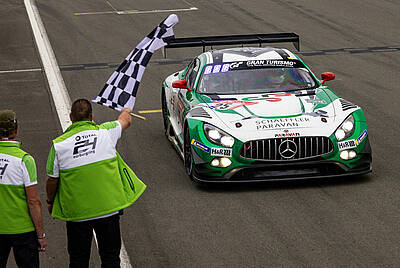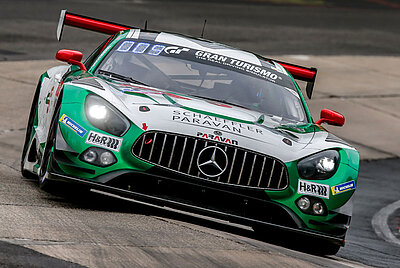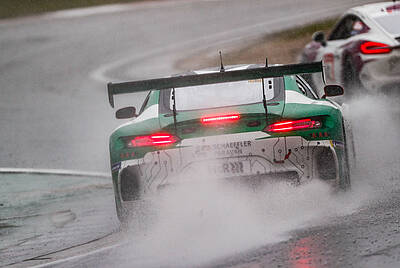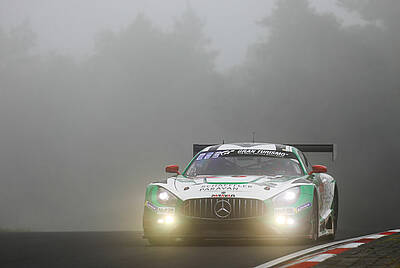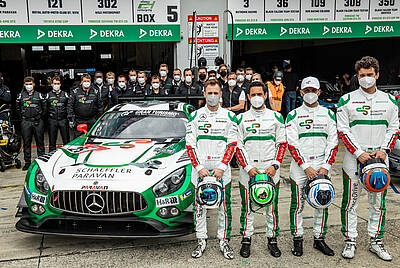The first GT3 vehicle - a Mercedes-AMG GT3 #25 - without a mechanical link between the steering unit and steering gearbox, equipped with the Space Drive steer-by-wire system, crossed the finish line in the history of the 49th ADAC Total 24 Hours Nürburgring. After a turbulent race and 56 laps, the technology carrier from Schaeffler Paravan Technologie GmbH und Co KG, driven by endurance specialists Philip Ellis, Darren Turner, Tim Scheerbarth and Dominik Farnbacher, crossed the finish line in 16th place overall and also won in its SPX class. The toughest race track in the world lived up to its reputation this weekend.
"It is a historic moment for our team. Today we wrote history for our Space Drive System and for development," said Roland Arnold, CEO of Schaeffler Paravan Technologie GmbH & Co. KG, who developed the system from mobility solutions for the disabled, after crossing the finish line. "For us, this was an important milestone. The Space Drive technology, has proven to be extremely robust under the most adverse conditions. We have received important information. We now need to use this information to make the technology fit for the car of the future."
On Saturday afternoon, the Mercedes-AMG GT3 with start number #25 started the race on the 25.378 kilometre long traditional track from position 32 in low clouds. The Space Drive Team played it safe and changed to rain tyres right at the beginning. After 30 minutes, the rain set in and became increasingly heavy - to the point of aquaplaning on some sections of the track. Starting driver Philip Ellis steered the #25 through the rain chaos unscathed and handed over to Briton Darren Turner in 33rd position after just under three hours. "I don't think I've driven a more difficult stint here on the Nordschleife," said Ellis afterwards. "There was a lot of aquaplaning out there, and yes accordingly extremely difficult conditions for everyone. The car feels good."
Darren Turner took over the cockpit after lap 15 in second place, again in the dry. "There was a lot of "Code60" on the track at that time. It was the first laps on slicks in this race. Each lap got faster and faster, an encouraging start," Darren Turner reported. Tim Scheerbarth then climbed into the Space Drive cockpit. His first outing was marked by rising fog on the Grand Prix track. "The fog kept coming down," reports Scheerbarth, who already piloted the Porsche Cayman 718 GT4 with Space Drive last year. "The steering was good. We now have to optimise the car further and set it up for the condi-tions we find here." On lap 31, Scheerbarth handed over the cockpit to Dominic Farnbacher in 26th place. The fog was getting thicker, especially around the Grand Prix circuit, Döttinger Höhe as well as the airport and Ahlenberg.
Late in the evening, the race control pulled the emergency brake - race interruption. "At times it was impossible to see from one marshal to the other. It is a wise decision to stop the race for the time being. Safety first," said Farnbacher.
After the restart, the Space Drive Mercedes-AMG started the race from position 26 with Dominik Farnbacher. Darren Turner and Tim Scheerbarth brought the #25 across the finish line confidently and without incident after 56 laps. They finished 16th in a tough field of starters, placing in the top 20 and securing the class win in the SPX.
For Space Drive, the distance, the demanding and material-demanding course of the Nordschleife and, above all, the adverse conditions at the beginning of the race were a real challenge. But it is precisely these extreme situations that are important for the Schaeffler Paravan data engineers in order to be able to generate reliable information and identify advantages and potential for improvement.
"The bumps and the bumps on the Nordschleife, you hardly feel them with Space Drive," says Dominik Farnbacher. "You don't get the bumps in your wrist. It's a bit more responsive. You get more feedback from the car and perceive everything a little differently, not through the steering wheel," reports starting driver Philip Ellis. "We are even closer to the conventional steering and were able to extract a lot of information in these extreme conditions," says Tim Scheerbarth, who already sat in the Space Drive cockpit of the Porsche Cayman GT4 last year. "In racing, you drive at the limit for a long time, which helps Space Drive to develop further quickly, also with the help of the feedback from the drivers here," says Darren Turner. He says the benefits are particularly no-ticeable in the carousel. The physical strain is less, especially over the long distance.
"It was a great day for us as a team and for space drive technology," said Hubert Hügle, CTO of Schaeffler Paravan. "We did the job 100 per cent. The Space Drive system worked brilliantly. Moving the vehicles in aquaplaning-like conditions is very difficult. That was a very big challenge for the Space Drive technology. We gained a lot of knowledge that we have to process and evaluate."
Since 1970, the 24h race at the Nürburgring has been one of the toughest and most prestigious rac-es in the world, alongside the 24h Le Mans. The competition twice around the clock on the 25.378-kilometre variant of the Grand Prix circuit and Nordschleife was held from 3 to 6 June. 121 cars took on the challenges of the endurance classic. Since its inception, the 24-hour race has always put new prototypes of racing cars as well as innovative technologies to an incomparable endurance test. Since the opening of the Nürburgring in 1927, the saying has been true: "Everyone praises what Nürburgring tests."
